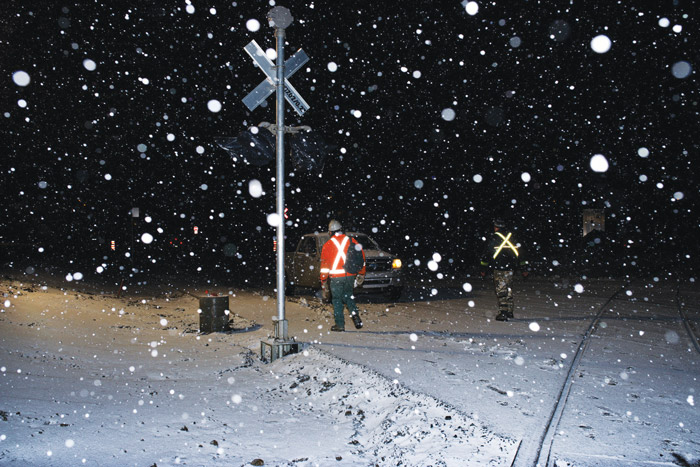For over two decades, Montreal photographer Benoit Aquin has made a name for himself through his blunt and captivating portrayals of environmental and human disasters. His unique investigative style of photography, in combination with his precise artistic vision, has earned him international acclaim and recognition. In July 2013, when a 74-car freight train was derailed in the small Quebec town of Lac-Mégantic, Aquin was one of the few photographers with access to the epicentre of the disaster. His photo series Mégantic, now on display at the Montreal Museum of Fine Arts (MMFA), provides a terrifying glimpse into the surreal landscape of the small town in the aftermath of overwhelming destruction.
Visitors of the exhibition are met upon arrival by the prominently displayed centrepiece of the exhibition: The striking diptych “Debris,” which occupies its own wall. It shows a twisted and tangled mess of oil-soaked metal, each panel mirroring the other to form a blossoming web of shrapnel and destruction. The irony of the beauty and butterfly-like appearance of the violently destroyed debris generates a powerful and lasting mental image.
The series consistently utilizes the emotional and visual power of extreme lighting contrasts, a technique well established by Aquin in his previous series, Quebec’s Far North. However, in comparison to his earlier works, Aquin uses blackness and predominantly dark fields more frequently, rather than light colours, to evoke a sense of dread and reverence. This technique is exemplified by what has become one of the most famous photographs from the series, “Zone d’Exclusion.” In this image, the temporary fence surrounding the disaster’s exclusion zone is presented in such a way that only pure blackness is visible behind it. The foreboding angle at which the fence is presented, in conjunction with the complete obscurity of all that lies beyond it, captures the essence of terror and devastation that lie within the site of the disaster.
One of the most striking features of Aquin’s style in the series is his general avoidance of human subjects. While there are occasional images in which residents or aide workers are featured, the vast majority of the photos are devoid of people in the foreground. This effectively creates a feeling of isolation, contributing to the alien and nightmarish feel to the scenes he illustrates.
Aquin’s focus in his previous work has strongly been the environmental impacts of both human and natural disasters, and as such, photographs in the Mégantic series frequently revolve around the widespread environmental destruction resulting from the catastrophe. Burned plants splashed with black oil and the polluted shores of the Chaudière River feature prominently throughout the gallery. Many photos centre on the human response to the pollution and, at times, highlight the absurdity and inadequacy of the methods. “Riviere Chaudière No. 6” shows several oil nets tossed into the river, while the banks are littered with oil and debris in other photos. The stark contrast between photos of the river before and after the incident indicates the true gravity of the disaster’s ecological impacts.
While environmental destruction is carefully documented, Aquin in no way overlooks the profound human tragedy of the event. He tastefully shows glimpses into the suffering and pain caused by the loss of nearly 50 lives. His most direct analysis of this is through the haunting work, “Andreé-Anne Sevigny, Jeune Victime,” a simple photograph of a listing of the funeral for a young woman who perished in the disaster. Photographs of abandoned homes, burned banknotes, and empty store shelves fill the gallery, emphasizing just how widespread the social implications of the destruction are.
Aquin’s years of experience in photographing disasters perfectly prepared him to document the horror and destruction of the Lac-Mégantic catastrophe. Through his understated yet painfully revealing work, his Mégantic series brings to light the true costs of one of the most devastating tragedies in Canadian history in an unforgettable and profound way.
Mégantic will be presented at the MMFA (1380 Sherbrooke) until Sunday, May 24. Student admission is $12.








